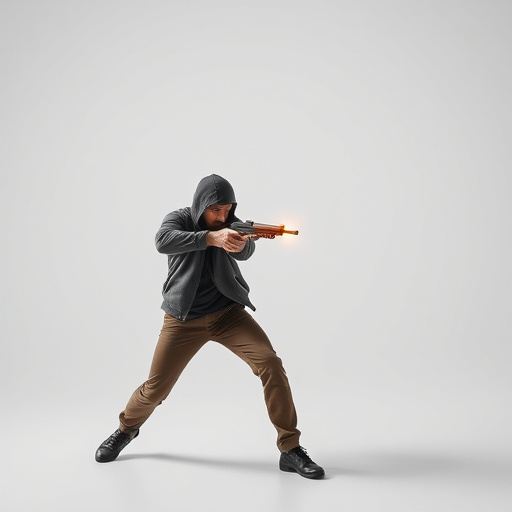Knowing the defensive pepper spray distance range (20-30 feet/6-9 meters) is crucial for safety in bear country. This range varies based on conditions but ensures effective incapacitation of bears with capsaicin spray. Correct application techniques, like aiming below eyes and nose, maintain this distance for optimal protection. Legal regulations differ; check local rules before using defensive pepper spray to avoid harm and ensure compliance.
Bear encounters can be terrifying, but knowing how to defend yourself with bear spray is crucial. In this guide, we explore the effectiveness of defensive pepper spray as a tool against bear attacks. Learn about the essential factors to consider, such as spray distance and range, application techniques, legal aspects, and safety tips. Understanding these key elements ensures maximum protection in grizzly territories.
- Understanding Bear Spray Effectiveness
- Choosing the Right Pepper Spray for Bears
- Optimal Defensive Spray Distance and Range
- Application Techniques for Maximum Protection
- Legal Considerations and Safety Tips
Understanding Bear Spray Effectiveness
Bear spray, also known as defensive pepper spray, is a popular choice for hikers and outdoor enthusiasts navigating bear country. Its effectiveness lies in its ability to create a protective barrier between the user and the bear, temporarily incapacitating the animal and allowing for escape or further defense. The spray’s active ingredient, capsaicin, irritates the bear’s eyes, nose, and respiratory system, causing it to retreat.
Knowing the defensive pepper spray distance range is crucial. Typically, bear spray is effective up to 20-30 feet (6-9 meters) away from the user, depending on factors like wind, terrain, and the sprayer’s technique. Understanding this range ensures individuals can use the spray appropriately during encounters, providing a valuable tool for personal safety in bear habitats.
Choosing the Right Pepper Spray for Bears
When considering bear spray as a defense against animal attacks, choosing the right product is paramount. The key factor to focus on is the defensive pepper spray distance range. This refers to the effective reach of the spray when deployed against an approaching bear. Products vary in terms of this range, typically ranging from 20 to 40 feet (6 to 12 meters). A higher distance range offers more protection, allowing users to maintain a safe distance from potential danger.
Additionally, look for sprays with proven effectiveness against bears. Active ingredients like capsaicin, the compound that gives chili peppers their heat, should be concentrated enough to deter an aggressive bear. Always check customer reviews and manufacturer claims to ensure you’re purchasing a reliable product. The right defensive pepper spray will provide peace of mind while hiking or camping in bear country, offering a valuable safety net against unexpected encounters.
Optimal Defensive Spray Distance and Range
When considering bear spray as a defense against animal attacks, understanding the optimal defensive pepper spray distance and range is crucial. For maximum effectiveness, experts recommend aiming for a distance between 20 to 30 feet (6 to 9 meters). This range allows for accurate application while maintaining enough distance to avoid direct contact with the spray, which can be harmful to your eyes and skin.
The ideal defensive pepper spray distance varies depending on the situation and the size of the animal. In dense forests or areas with low visibility, it’s best to err on the side of caution and use a shorter range, around 20 feet (6 meters), as you may not have a clear line of sight. Conversely, in open spaces, extending the range up to 30 feet (9 meters) can provide more leeway for proper application without putting yourself at unnecessary risk.
Application Techniques for Maximum Protection
For maximum protection against animal attacks, proper application techniques are paramount. When using defensive pepper spray, it’s crucial to understand the optimal distance range for deployment—typically around 20-30 feet (6-9 meters). Aiming slightly below the target’s eyes and nose ensures direct contact with the most sensitive areas. Hold the can upright, shake well before use, and release the trigger in a swift, continuous motion, creating a broad spray pattern to cover your defensive distance range effectively.
Remember that consistency is key. Practice your application technique regularly, especially if you’re in bear country or other high-risk areas. Understand that different animals may require slightly adjusted strategies, but the foundational principle remains: aim for the eyes and nose, maintain a safe defensive pepper spray distance range, and deploy swiftly to deter potential attacks.
Legal Considerations and Safety Tips
When considering defensive pepper spray as a tool for animal attack prevention, it’s crucial to understand legal considerations. The use of bear spray or other defensive pepper sprays is regulated by local, state, and national laws, which vary significantly. Always check your region’s specific rules regarding pepper spray ownership, carry permits, and permissible uses. Some areas may restrict its use to specific wild animal encounters, while others might allow it for personal protection against any aggressor.
Safety tips are paramount when handling defensive pepper spray. Familiarize yourself with the spray’s effective distance range—typically around 20-30 feet (6-9 meters)—and understand that aiming accurately under stress is challenging. Regularly practice to improve your technique, and keep the spray in an easily accessible yet secure location. Additionally, ensure proper ventilation during use, as pepper spray can also affect bystanders if misused or in enclosed spaces.
Bear spray, when used correctly, can be an effective defense against bear attacks. Understanding its effectiveness, choosing the right product, knowing the optimal defensive spray distance and range, and mastering application techniques are key to ensuring your safety in bear country. Always stay aware of local regulations and follow safety tips to enhance your protection while enjoying the outdoors.
